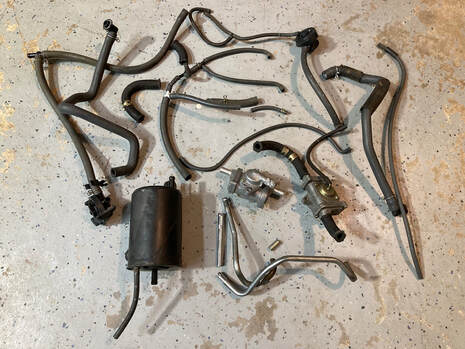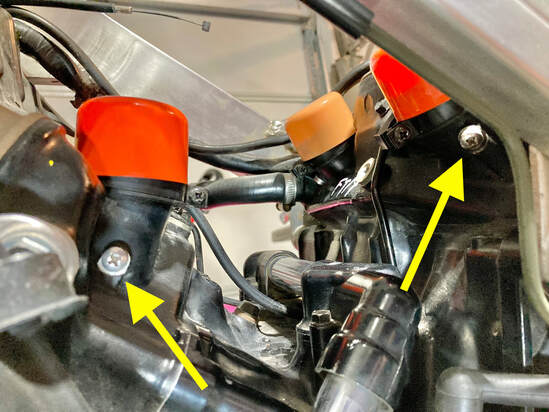
The purpose of all this plumbing is to capture the carburetors' evaporative fuel vapors and send them back into the engine to be re-burned rather than escape to the atmosphere. A secondary function was to inject fresh air into the exhaust ports (PAIR system), igniting unburned vapors exiting the engine, again preventing vapors escaping out the exhaust pipes. A noble endeavor, but after 29 years or so we have no way of knowing how effective the system is or if it may even be causing a drivability issue. A further rationalization for binning the whole affair is that our old bikes have mostly been relegated to occasional recreational use, and so their contribution to the warming of our planet will be minuscule at best. In any case, out it goes.
Beginning at the carburetors, I simply follow the various hoses along their paths, removing hardware parts as I go, culminating at the charcoal canister located near the #2 exhaust pipe. In addition, I'll unbolt the PAIR injection pipes from the front two cylinders at the exhaust ports. The rear two will be left in place, as they're nearly impossible to unbolt without removal of the shock, etc. These four pipes will need to be plugged, and for that I'll use four allen-head screws, pictured below. Screw or hex-head bolts will work just as well. I use 3/8" course threads.
My technique is to tap threads into the four pipes and insert the plugs coated in an epoxy, in this case JB Weld (this procedure is also covered on the "Maintenance" page). I begin by cutting the brackets off the front pipes, leaving enough pipe to thread and plug. I'll need to tap the rear pipes where they exit on the right side of the engine area. In the photos the new threads being cut are visible on the outside of the soft metal pipes.
(click on an image to enlarge)
For the carbs, you can simply slip a rubber vacuum cap over them, but I'm more comfortable with a permanent mechanical seal, just like the PAIR plugs covered above. NOTE: This procedure is only possible with the carburetors separated, so if that's not the case, we'll need to use the vacuum caps.
There's two sizes of pipes on the carburetors. For these I use hardware store self-tapping metal screws, numbers 6 and 8, 1/2' in length. I first gently tap the pipes with a dry screw — go slowly, these are brass pipes and could easily split open. Remove the screw, coat with JB Weld and snug into place. For a neater job, a Dremel cutoff tool will quickly slice the screw head off, but there's not always access for the tool. In any case, they're not visible when assembled.













 RSS Feed
RSS Feed